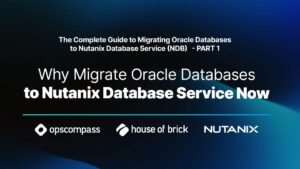Bob Lindquist, Director of Client Services
House of Brick Technologies has been assisting clients with their business-critical applications for over twenty years. In that time, we have seen many changes regarding how database platforms are deployed, licensed, and managed.
Over the past few years, we have consulted with a growing number of organizations deploying database workloads on the cloud. While there have been a few challenges, such as concerns about licensing, they have been outweighed by the benefits including self-managed database services.
Amazon Web Services (AWS) has accelerated adoption of database on cloud deployments. While some organizations have chosen to move slowly, House of Brick has helped others to quickly deploy databases to cloud. The following perspectives offer a variety of real-world examples.

Client #1 – Oracle to Amazon RDS & Aurora PostgreSQL
The organization had distributed deployments of their critical systems based on Oracle technologies. Hardware and software support were provided by different groups, some of which were outsourced.
While Oracle Enterprise Edition had originally been deployed, it was determined that Standard Edition could be used instead, for a considerable reduction in cost. Also, many of the legacy workloads could be migrated to, and supported on, PostgreSQL offering further savings.
AWS was the target cloud provider, and Amazon Relational Database Services (RDS) provided an Oracle self-managed service for Standard Edition, which also came with the needed license, so the organization no longer needed to engage Oracle directly. The legacy workloads that could move to PostgreSQL also leveraged RDS with Aurora PostgreSQL.
It was determined that the organization could save over 70% of their annual Oracle spend by deploying their workloads using these AWS database services.
Client #2 – Audit Defensible Oracle to Aurora PostgreSQL
A large international company had been running Oracle for more than 30 years. Their application software was built in-house to leverage Oracle for its high availability and solid performance.
The cost and related support costs of this Oracle deployment, along with other IT initiatives, were the main reasons for the company considering AWS as a cloud option. However, Oracle licensing seemed to be an obstacle to moving their databases from on-premises to the cloud. An audit was a real concern, given their history with Oracle, and ultimately led to their decision to move off Oracle database to PostgreSQL.
They took a deliberate two-stage approach to moving to the cloud and migrating off Oracle. The first stage included assessing their Oracle license position, and following a license transition plan for deploying Oracle on Amazon Elastic Compute Cloud (EC2). The second stage involved prioritizing database workloads for a move to Aurora PostgreSQL, while eventually exiting all Oracle agreements.
By taking a staggered approach, and conducting the necessary diligence on their Oracle licenses, the company was able to migrate off Oracle to Aurora PostgreSQL in an audit defensible manner.
Client #3 – Oracle Database Appliances to Amazon RDS for Oracle SE
A smaller organization had to purchase Oracle Database Appliances (ODAs) in order to settle a previous audit with Oracle. However, the ODA hardware was much more than what the organization needed for their off-the-shelf application. The ODAs not only increased the ongoing support costs, but were also sold with more expensive Oracle Enterprise Edition licenses instead of Standard Edition (SE).
Rather than upgrading to new ODAs, or other Oracle hardware, the organization decided to optimize their Oracle deployment. Their application provider supported AWS, and also supported Tomcat, eliminating the need for an expensive Oracle application server.
Amazon RDS for Oracle was the selected database service. Moving from Oracle Enterprise Edition to Standard Edition also allowed use of the License Included option of Amazon RDS for Oracle. They were also able to run Tomcat as the application server on AWS.
Moving off the ODAs and to Amazon RDS meant that the organization would no longer need direct software or hardware agreements with Oracle. The move also significantly reduced ongoing support needs, so the IT staff could focus instead on servicing their end users.
Summary – AWS and HoB Provide Real-World Database on Cloud Options
These and other real-world options are available for organizations considering migrating their database workloads to cloud. Here are some additional resources:
Running Oracle on AWS – FAQ
House of Brick has accumulated a number of frequently asked questions (FAQs) on Oracle to AWS options, some of which include:
- What are my options for licensing Oracle on AWS?
- Should I consider RDS, EC2, or VMware Cloud on AWS?
- How can I optimize for Oracle performance on AWS?
In addition to the questions addressed, the FAQ also provides links to a variety of recent House of Brick blogs, white papers, and conference presentations.
Don’t Miss the AWS Summit on May 13th
House of Brick encourages you to participate in the upcoming AWS Summit virtual event on May 13th. Keynote speakers include Dr. Werner Vogels, CTO – Amazon.com, and Andy Jassy, CEO – Amazon Web Services.
The summit agenda includes a key session in the Analytics and Databases track that will feature many of the topics included the above examples. A description of the session is below.
Database freedom: Break free to save, grow, and innovate (Level: 200 – Intermediate)
Hundreds of thousands of customers have broken free from old-guard database providers to run on AWS databases, which provide commercial-grade features at one-tenth the cost. AWS databases merge the flexibility and low cost of open-source databases with the robust enterprise features of commercial databases, freeing teams from the heavy lifting of database administration. In this session, learn how AWS databases were designed to support the scale, performance, and availability demands of modern globally distributed applications with microservices architectures.






